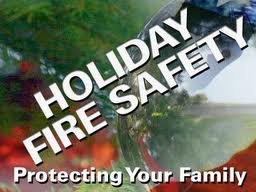Sheriff Mike Tregre advises,
Keep Fire Safety on the forefront of your holiday planning.
 As the holiday season approaches, Sheriff Tregre urges you to keep fire safety in mind when you do your holiday decorating. Whether it is careful candle placement or checking the warning label on the holiday lights, simple safety steps can go a long way in preventing fires and injuries this year.
As the holiday season approaches, Sheriff Tregre urges you to keep fire safety in mind when you do your holiday decorating. Whether it is careful candle placement or checking the warning label on the holiday lights, simple safety steps can go a long way in preventing fires and injuries this year.
Annually, during the two months surrounding the holiday season, more than 14,000 people are treated in hospital emergency rooms due to injuries related to holiday decorating. In addition, Christmas trees are involved in hundreds of fires resulting in an average of 15 deaths and $13 million dollars in property damage annually. Candle-related fires lead the list of hazards averaging more than 12,000 a year, resulting in 150 deaths and $393 million in property damage.
Sheriff Tregre said, “People turn their attention to shopping, tree-trimming and social gatherings, overlooking the fact that the threat of fires in the home is most severe during this time.†According to the National Fire Protection Association, December, January and February are the leading months for home fires and home fire deaths in America.
To help ensure a joyful Christmas and fire-safe holiday season for everyone, Sheriff Jones advises that the following basic fire safety guidelines be observed.
PREVENTING CHRISTMAS TREE FIRES:
Special fire safety precautions need to be taken when keeping a live tree in the house. A burning tree can rapidly fill a room with fire and deadly gases.
- When selecting a tree, needles should be green and hard to pull back from the branches, and the needle should not break if the tree has been freshly cut. The trunk should be sticky to the touch. Old trees can be identified by bouncing the tree trunk on the ground. If many needles fall off, the tree has been cut for too long, has probably dried out, and is a fire hazard.
- Do not place your tree close to a heat source, including a fireplace or heat vent. The heat will dry out your tree, causing it to be more easily ignited by heat, flame, or sparks. Do not put your live tree up too early, or leave it up for longer than two weeks. Keep the tree stand filled with water at all times.
- Do not place a tree in a doorway or in front of escape routes.
- When disposing of your tree, never put tree branches or needles in a fireplace or wood burning stove. When the tree becomes dry, discard it promptly. The best way to dispose of your tree is by taking it to a recycling center or having it hauled away by a local community pick-up service.
HOLIDAY LIGHTS:
- Inspect holiday lights each year for frayed wires, bare spots, broken or cracked sockets, and excessive kinking or wear before putting them up.
- Use only decorative lights approved for the specified use you have in mind.
- Do not use outdoor lights inside the house and vice versa.
- Do not overload electrical circuits with excessive lighting and extension cords
- Do not leave holiday lights on unattended.
HOLIDAY DECORATIONS:
- All decorations should be nonflammable or flame-retardant and placed away from heat vents.
- Never put wrapping paper in a fireplace. It can result in a very large fire, throwing off dangerous sparks and embers that may result in a chimney fire.
- Keep children and pets away from light strings and electrical decorations.
- If you are using an artificial tree, make sure it is marked “flame retardant.â€
CANDLE CARE:
- If you use candles, make sure they are in stable holders and place them where they cannot be easily knocked down.
- Never leave the house with candles burning.
- Keep candles away from flammable areas, and never put them on or near a tree.
- Do not display candles in windows or near exits.
- Keep all candles, matches, and lighters out of the reach of children.
- Beware of glass candle holders. The wick may get too close to the glass and shatter it.
HOLIDAY ENTERTAINING:
- Unattended cooking is the leading cause of home fires in the U.S. When cooking for holiday visitors, remember to keep an eye on the range.
- After holiday parties, check for cigarettes in upholstered furniture before going to bed. Cigarette fires are still the leading cause of fire fatalities in the home.
- This is a good time of year to do an annual test of all smoke detectors, replace batteries, and rehearse an escape plan with your family.
Sheriff Mike Tregre concluded, “We all have a tendency to think that fire tragedies happen to other people in other places, but the reality is that they can happen to people just like you and me. And, it is important that we all do our part to make this a happy and safe Christmas holiday season.â€
On the Net:
National Fire Protection Association: http://www.nfpa.org
Home Fire Prevention & Safety Tips: http://www.usfa.fema.gov
Family Fire Safety Tips: http://www.ready.gov/home-fires
